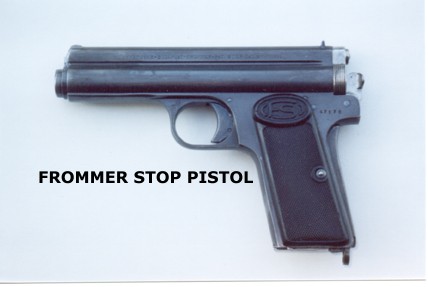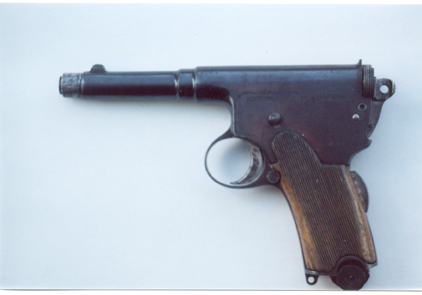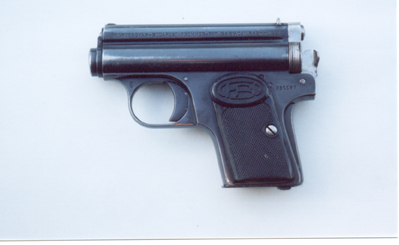 |
 |
 |
|
|
|
|
CRUFFLER.COM
presents
HISTORIC
FIREARM OF THE MONTH,
August
2000:
 |
 |
 |
 |
Type:
Self Loading Pistol
System of Operation: Long Recoil Caliber: 7.65mm Browning and 9mm Browning Short Capacity: 7 rounds (Stop), 5 rounds (Baby) Sights front: Blade Sights, rear: Notch Length: 6.5" (Stop), 4.875" (Baby) Weight (unloaded): 1.6 lbs (Stop), 1.4 lbs (Baby) Barrel: 4" (Stop), 3" Baby |
article by Merv Broten
HISTORY
The Frommer
Stop and Frommer Baby pistols are the culmination of a series of handgun
designs by Rudolph Frommer based on the long recoil system of operation.
Long recoil refers to the fact that the bolt and barrel remained locked
together as they recoil rearward for a distance greater than the length
of the cartridge.
Rudolph Frommer was born in Budapest, Hungary, in 1868. Educated as an engineer, he was hired by Fegyvergyar, “Small Arms-and-Machine-Company” in Budapest in 1896. There, he worked on developing semi-automatic handguns, and also machine guns. By 1906, he had been appointed general manager. His name is often linked with that of Austrians Karl Krnka and Georg Roth, with whom he collaborated on early handgun designs. Frommer stayed at Fegyvergyar until 1935, by which time he had registered over 100 patents. He died in Budapest in 1936.
Frommer’s first
handgun design was the Model 1901. It was of long recoil design,
had a 10 round fixed magazine in the grip that was loaded by a charger
from above, and was chambered for an 8mm cartridge. The Model 1901
was submitted in the military selection trials of a number of countries,
but was not chosen. In 1906, Frommer slightly redesigned the pistol
to incorporate some manufacturing improvements, and also changed the caliber
to 7.65mm Frommer. This is the same cartridge as the 7.65mm Roth
Sauer, dimensionally similar to a .32 ACP with a shorter cartridge case.
The first Model 1906’s were charger loaded from the top like the Model
1901, but the design was soon changed to a conventional box magazine inserted
into the bottom of the grip frame. The next step in the evolution
was the Model 1910, which added a grip safely to the rear of the grip.
Contrary to what is sometimes written, the Model 1910 was also chambered
for the 7.65mm Frommer cartridge, never the .32 ACP – the magazine well
is much too short. Total production of the M1901, M1906, and M1910
is hard to estimate. They were probably serial numbered in the same
block of numbers. M1910’s are found in the 7000 to 10000 range.

Frommer M1910 |
The M1910 still did not meet with much success. With an eye toward commercial sales, Frommer set to work to redesign his gun. He retained the long recoil system, but he drastically changed the frame profile both to give it the shape of a “modern” semi automatic pistol, and also to simplify manufacturing. He changed the caliber to the more popular and universal .32 ACP (7.65mm Browning) and .380 ACP (9mm |
The Frommer Stop is about 6 1/2 inches long, 4 1/2 inches high, 7/8 inch thick, and weighs 21 ounces. Magazine capacity is 7 rounds in both .32 and .380. The grips are either black horn or wood. The Frommer Baby is basically a cut down Stop. All parts except the frame, barrel, spring guide, grip safety, magazine, and grips interchange. It is about 4 7/8 inches long, 3 1/2 inches high, 7/8 inch thick, and weighs 15 1/2 ounces. Magazine capacity is 5 rounds in both .32 and .380. The grips are black horn.
The Frommer Stop and Baby were patented in 1912. Like all of the previous Frommer pistols, manufacture was at the Fegyvergyar factory in Budapest. Production was slow at first, undoubtedly due to the fact that between 1911 and 1914, the Fegyvergyar factory was committed to the production of the Roth Steyr pistol for the Imperial Austro-Hungarian Army.
Frommer Stops
and Babys have a large assortment of proof marks, located on the left trigger
guard. Military guns usually have the Hungarian crest, sometimes
accompanied by the Austrian crest, and the letters Bp and a two digit date.
Commercial guns usually have the Hungarian commercial proof, which consists
of a crown over the letters BP, all enclosed in a circle. Only one
set of serial numbers was used to number both Babys and Stops, and it was
probably a continuation of the serial numbers of the previous Frommer models.
| Most of the early guns produced were the Baby version, in both .32 and .380, for the commercial market. They are found in the 20000 to 30000 serial number range. With the beginning of WWI in 1914, handguns of all types were needed by the Austro-Hungarian Empire. The Hungarian Honved, (roughly equivalent to our National Guard), was equipped with Frommer Stops, the first deliveries |

Frommer Baby |
After WWI, Hungary became an independent country. The Frommer Stop in caliber .32 was chosen as the official military handgun, and was given the designation Piztoly M19. Proof marks for these guns are military proofed and dated 20, 21, or 22. After 1922 the two digit date was dropped. These military guns continue up to about serial number 350000.
At about serial number 350000, Fegyvergyar began manufacturing Babys again, in .32 caliber. Most were commercial proofed for the civilian market, but a few were military proofed with just the Hungarian crest, supposedly for issue to the pilots of the Hungarian Air Force. Beginning at serial number 360000, a small run of .380 caliber Babys was made. Full size Stops are also interspersed throughout this serial number range. Production stopped somewhere above serial number 363500, probably in 1929 when Fegyvergyar started manufacture of the new 29M pistol for the Hungarian military.
OPERATION
As stated
before, the Frommer Stop functions by long recoil, locked breech operation.
The breech is locked by a rotating bolt that locks into recesses in the
barrel extension. The operating sequence goes something like this:
When the cartridge fires, the bolt and barrel are locked together, and
recoil rearward for a distance that is greater than the length of the cartridge.
The barrel and bolt each have their own recoil springs, housed in the spring
tunnel on top of the frame. At the end of the rearward travel, the
bolt is held back by the bolt catch, and the barrel is free to return,
powered by its’ recoil spring. As the barrel returns forward, it
pulls away from the bolt, causing the bolt head to rotate and unlock.
The fired case is held against the bolt face by the extractor, and the
barrel actually pulls away from the case, not the other way around.
As the case clears the chamber, an ejector kicks it out the ejection port.
When the barrel returns all the way forward, it trips the bolt catch and
the bolt snaps forward, powered by its’ separate recoil spring. On
its way forward, the bolt strips the next round from the magazine, and
the gun is ready to fire again. Simple, huh?
There are both advantages and disadvantages to the long recoil system in a handgun. One advantage is that the weight of the gun can be less, as the heavy slide of a blowback operated gun is unnecessary. Also, the recoil energy is spread out over a longer time span, and is absorbed by more moving parts, so felt recoil to the shooter is less. Disadvantages are that there are more total parts in the gun, that require more complicated machining, and therefore the cost of the gun to manufacture is higher. Also, Frommers are somewhat sensitive to the power of the ammo used, requiring a fairly stout load.
I am always
looking for Frommer serial number and proof mark information for my data
base, and am interested in purchasing Frommer Stops and Frommer Babys for
my collection. If you know of a Frommer for sale, or have information
about Frommers, please email me at kashyyyk@execpc.com.